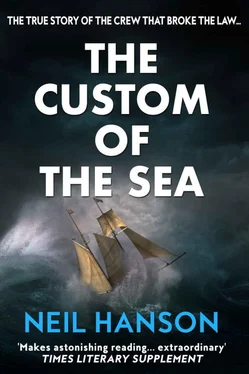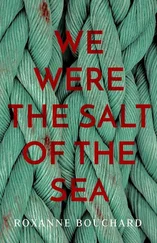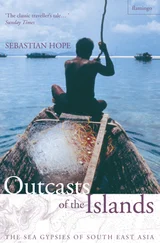They set off towards the distant shore, towed by the ships’ boats, but after a short distance the officers in the boats cut the raft adrift and rowed away, leaving the survivors to their fate. The raft was so heavy-laden that the survivors were waist deep in water, and so overcrowded that the rough seas were continually washing people overboard. Mutiny broke out and wholesale killings began.
One of the eventual survivors recorded that,
Those whom death had spared during the night fell upon the dead bodies with which the raft was covered, and cut off pieces which some instantly devoured… Those of us who had firmness enough to abstain from it, took a larger quantity of wine. We tried to eat sword-belts and cartouche-boxes, and succeeded in swallowing some little morsels. Some ate linen, others pieces of leather from the hats, on which there was a little grease, or rather dirt. A sailor attempted to eat excrement, but could not succeed.
On the following nights, a further mutiny and more acts of violence reduced the raft’s complement to thirty men, half of them wounded. Rather than waste rations on men who were likely to die anyway, the other fifteen decided to throw the wounded into the sea, retaining a few dead bodies as food. The fifteen survived to be rescued on the seventeenth day adrift, but five died soon afterwards.
If the Medusa was the most celebrated incident, there was no shortage of others. A Dutch physician, Nicholaus Tulpius, published a seventeenth-century account of a ship carrying seven Englishmen which set out from St Christopher — now St Kitts — in the Caribbean for a journey expected to last one day. However, a storm drove the ship out to sea and the crew were lost for seventeen days. They drew lots to see who should die to feed the rest and also cast lots for the executioner.
When the lots were drawn, the man who had suggested the idea was the victim. He was killed, his blood drunk and his body eaten. The survivors were eventually washed ashore on the island of St Martin. When they returned to St Christopher, they were put on trial for murder, but all were acquitted, on the grounds of ‘inevitable necessity’.
In an eighteenth-century case, the Peggy sailed for New York on 24 October 1765, carrying a cargo of wine and brandy. Five days later the ship was hit by violent storms. Over the course of the following month of incessant gales, the sails were torn away one by one, until the ship was left with a single mainsail.
Her captain, David Harrison, later reported,
The conflict which our vessel had so long maintained against waves and winds had by this time occasioned her to leak excessively, and our provisions were so much exhausted that we found it absolutely necessary to come to an immediate allowance of two pounds of bread a week for each person, besides a quart of water and a pint of wine a day.
The food and water soon ran out altogether. The starving crew, working desperately by day and night to keep their ship afloat, began to plunder the cargo of liquor. On Christmas morning they seemed to have found salvation when a ship appeared to leeward of them. Harrison spoke to the captain, explained their plight and asked him to take them on board.
The man refused, even though Harrison swore that none of his crew would touch a scrap of the other ships provisions. All the other captain would do, he said, was to give them some hard-tack, once he had finished taking his noon sun-sight. Harrison went below to rest, but a few moments later some of his crewmen burst in on him. The other ship had made sail without throwing them so much as a crumb.
As long as my poor fellows could retain the least trace of him they hung about the shrouds or ran in a state of absolute frenzy from one part of the ship to the other. They pierced the air with their cries, increasing in their lamentations as she lessened upon their view.
Two pigeons and the ship’s cat still remained on the Peggy . The two birds were eaten that day and the cat the next. The crewmen cast lots for portions of it, Harrison drawing the head.
I never feasted on anything which appeared so delicious to my appetite. The piercing sharpness of necessity had entirely conquered my aversion to such food, and the rage of an incredible hunger rendered that an exquisite regale which on any other occasion, I must have loathed with the most insuperable might.
On 28 December an even more savage storm struck the ship and tore away the mainsail. The crew continued to drink the liquor from the cargo and ate their tobacco and candles, the bone buttons from their jackets and every scrap of leather they could find, even taking the ship’s pumps apart to get at the leather washers inside.
They then told the captain that they had drawn lots and the short straw had fallen on a slave, ‘a poor Ethiopian’, who was part of the cargo. He was shot dead, cooked and eaten. One crewman, too impatient to wait for the body to be cooked, tore out the dead man’s liver and ate it raw. He went insane and died three days later, but his body was thrown overboard untouched lest his madness be ingested by his fellows along with his flesh.
The captain refused to eat any of the slave’s body and kept his loaded pistols at his side to deter his men from making him their next repast. They rationed the meat to last nine days, then lots were again cast. The captain refused at first to be involved, but decided that if the lots were not drawn in his presence ‘he might not himself be fairly treated’.
The short straw was drawn by a popular crewman and some hours elapsed while they decided whether to eat him. The mental strain on him was more than he could bear, however, and he became deaf and then insane. The next morning, a ship appeared on the horizon. When the crew rushed in to tell Harrison they were saved, he almost shot them, fearing that it was his turn to be eaten.
Even after his rescue, Harrison ate virtually nothing for four days, except a little broth. When at last he ate some solid food he was shortly afterwards gripped by
an occasion for a particular indulgence of nature. I thought I should have expired performing it. The pain it gave me was excruciating to the last degree and the parts were so contracted, having never once been employed for a space of thirty-six or thirty-seven days, that I almost began to despair restoring them to their necessary operations. I was, however, at last relieved by the discharge of a callous lump about the size of a hen’s egg.
An even more famous and terrible case than the Peggy involved the Cospatrick , 1,200-ton, teak-hulled ship built in Rangoon and launched in 1856. It saw many years’ service as a troop-carrier, so many that the boots of the soldiers had worn the planks of its decking into hollows. It had also carried out the less respectable trade of ‘blackbirding’ — kidnapping men to be sold to slave traders — before it was bought by Shaw, Savill & Albion in 1873 to carry emigrants to New Zealand.
On 8 September 1874, it sailed from Gravesend under Captain Elmslie, on a voyage to Auckland. It carried 433 passengers, including 127 children and 42 crew. By 18 November the ship was well past the Cape in the roaring forties, running east towards New Zealand through a heavy swell, when at one in the morning a fire broke out in the boatswain’s store in the forepeak.
It was caused either by a match thrown down a grating by one of the emigrants or by the oil lamp used by the boatswain — ‘a very careless man’, in the words of one of the survivors. The store was packed with paint, linseed oil, tarred ropes and oakum. A shaft running from the forepeak to an open skylight on the forecastle head acted like a chimney, accelerating the blaze.
Any hopes of containing the fire were lost as the ship swung head-to-wind. The helmsman was later blamed for this, but it is possible that the fire had burned through the halyards holding the head sails of the ship. If so, no helmsman in the world could have stopped the wind from driving the ship round.
Читать дальше











